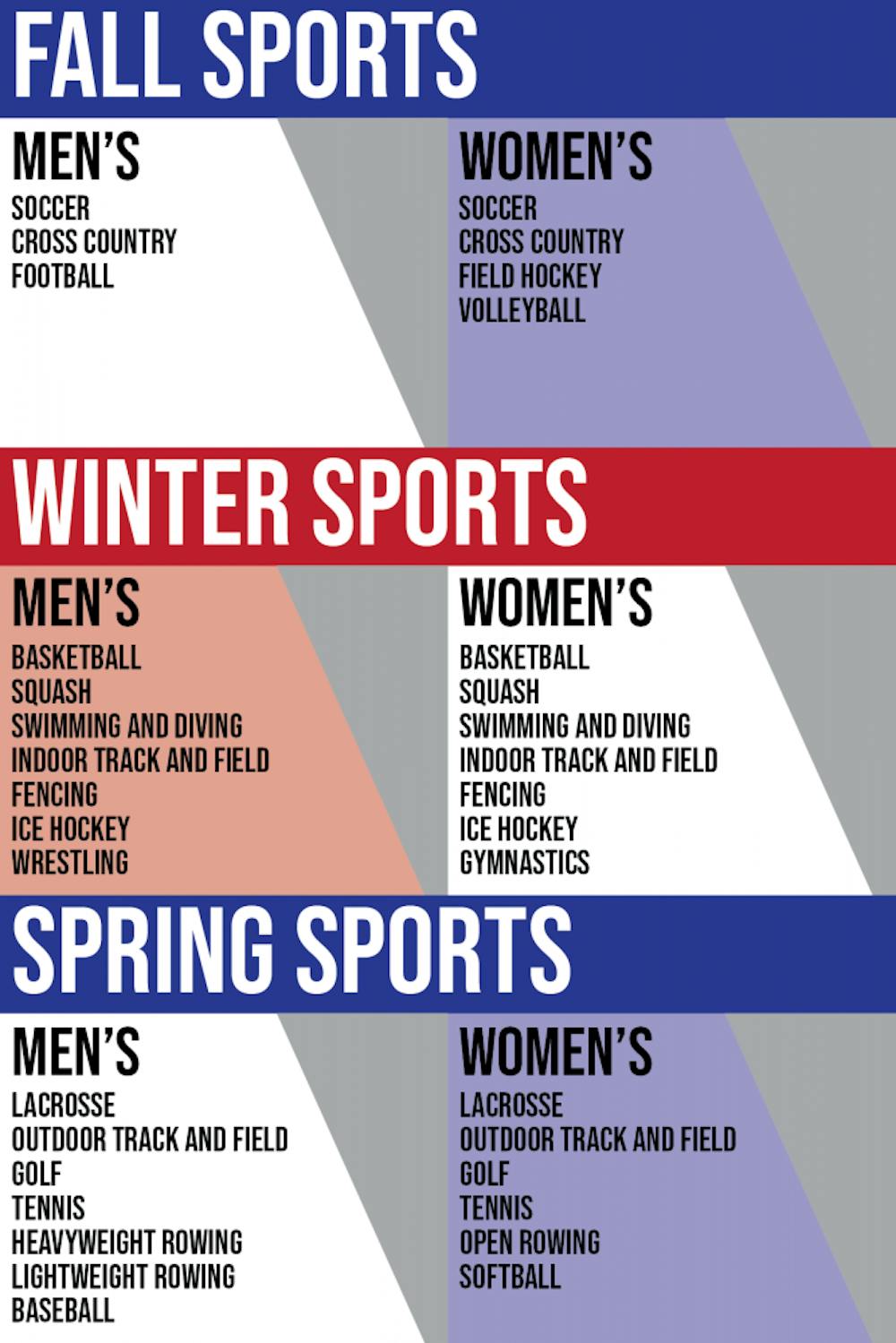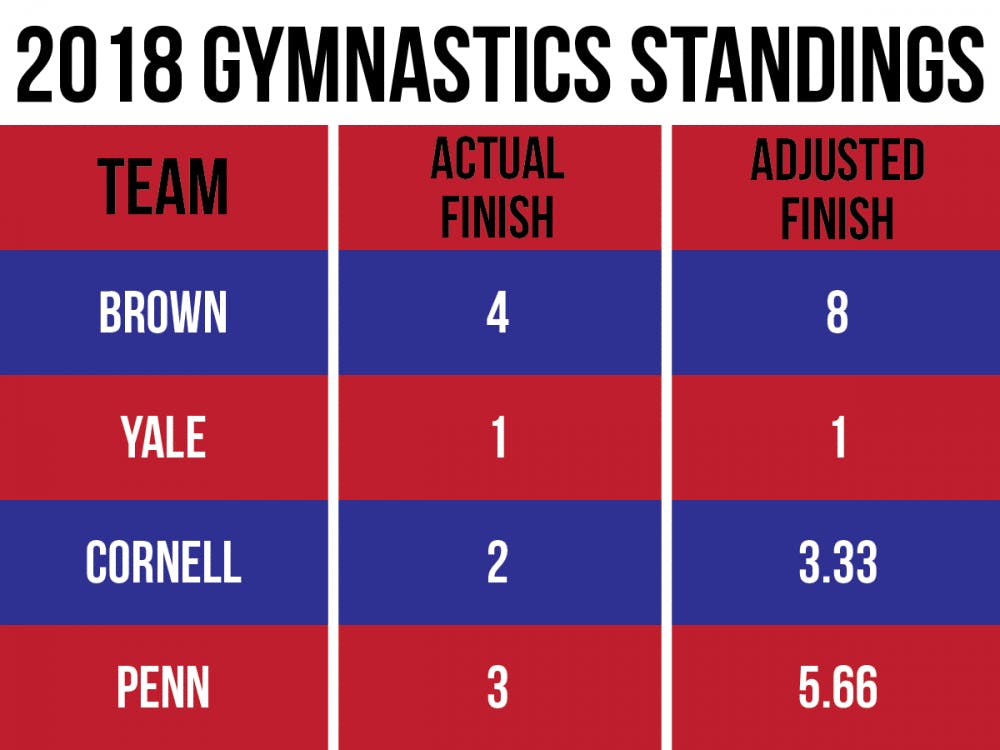
Our study includes 34 varsity teams.
Credit: Chase Sutton , Christine LamAs you’ll see over the next few months, The Daily Pennsylvanian has begun an extensive project comparing the overall performances of the Ivy League’s eight athletic programs. Projects with similar motives have been done before; most notably, the NACDA Directors’ Cup compares all NCAA teams to one another at the end of each trimester. But the Directors’ Cup only considers up to 20 sports teams for any school, and it only rewards postseason success; for example, a national champion gets 100 points, a second-place team gets 90, and so on, down to 5 points for teams at the end of the top 100.
But in the Directors’ Cup, there’s no reward for regular season conference championships, there’s no tangible difference between finishing second in the Ivy League and finishing eighth, and there is no way to measure any school’s talents across every single sport. This study aims to change that — we go in depth to measure just about every aspect of the eight Ivy athletic programs. Our methodology is as follows:
Overview
We considered all sports where at least half of the Ivy League competes at the varsity level. This means that we did not include certain sports in which only a few Ivies compete, such as sprint football, men’s and women’s skiing, men’s volleyball, men’s and women’s water polo, etc. We felt it unfair to judge a team’s success in a sport relative to the rest of the league in cases where most of the league doesn’t compete. Here’s a breakdown of the sports we considered, grouped by season:

We took data from the past 10 complete school years, going back to 2008-09. We saw this as a solid compromise between being large enough to have a sample size indicative of which schools were best, yet small enough to reasonably demonstrate which programs are the best right now. For each season, teams were ranked based on the final standings.
For sports where some Ivy teams don’t compete, each team’s finish was adjusted to an eight-team scale, with the first-place team remaining at 1 and the last-place team finishing 8. The formula is 8-(7*(X-Y)/(X-1)), where X = number of teams and Y = finish within in the league. This does not apply to situations where teams were forced to forfeit competitions or an entire season for disciplinary reasons. Those teams were given last-place finishes. Schools were not penalized for not having a team in a particular sport.

Titles were split into outright and overall titles to account for shared titles. In the case of a shared title, each team that earned a part of the Ivy title were given a championship. For sports with a conference postseason tournament, postseason champions were recorded separately. This applies to basketball and lacrosse, but not baseball or softball. For sports in which the Ivy League schools compete in a separate conference, such as the ECAC, championships that teams won were counted as “other conference championships.”
Premiere postseason appearances, wins, and national titles refer to the NCAA Championship or Tournament, or each sport’s equivalent of that (see below for exceptions). When applicable, byes were counted as wins. We felt it was unfair to penalize teams for being rewarded with a higher seed and not having to play early round games.
Tiebreakers
We felt it was important to not have any ties in our study, as it would have made our analysis much more complex. Instead, we came up with a set of general tiebreakers that were used to break any ties in the standings. This applies even when teams share the Ivy title, as we still distinguished who came in first and second place. The tiebreakers are as follows, in order:
- Head-to-head record (for more than two-team ties, it is the combined head-to-head record)
- Higher seed in conference tournament
- Ivy point differential
- Head-to-head point differential
- RPI or similar metric
While these tiebreakers worked for most sports, there were several sports that required more sport-specific rules. These are explained below.
Sport-specific rules
- Baseball/Softball: The regular season Ivy League champion is the winner of the Ivy League Championship Series, and there is no postseason champion.
- This is because the Ivy League treats the ILCS winner as the Ivy League champion, whereas other sports with postseason tournaments have separate postseason champions.
- To rank the Ivy teams, the ILCS winner is 1, then we sort by regular season records for 2-8.
- Rowing: The Varsity Eight race is used to determine Ivy League results.
- However, team national finishes are judged by a school’s overall point totals across all events at the IRA or NCAA Finals. We treat winning the Varsity Eight at IRAs or NCAAs as an individual national championship.
- Fencing: Tiebreakers are head-to-head, then overall plus/minus, then individual event wins.
- Also, the NCAA awards fencing national championships and tournament appearances jointly to both men’s and women’s teams. These are counted once in the overall school’s statistics, but are counted twice in each team’s statistics — once for both the men’s and women’s teams.
- Squash: Columbia did not play in the Ivy League at the varsity level until 2011-2012, so prior Ivy results are adjusted.
- Cross country and golf: The tiebreaker is the best individual finisher at the Ivy Championships.
- Swimming and track and field: The tiebreaker is which team has more individual Ivy champions across all events.
- Gymnastics: The tiebreaker is which team had the highest team score in the most events, and then which team had the most individual event wins.
- For sports that have a national championship rather than a national tournament, we tracked each school’s average finish across all of its appearances. We also marked each school’s top-25, top-10, and top-5 finishes.
- Several sports do not have an NCAA-sponsored tournament or championship. These include football (no postseason), men’s lightweight and heavyweight rowing (IRA), and squash (CSA).
With all that said, we hope our readers learn from our findings. Contact dpsports@thedp.com with any further questions regarding our methods or general commentary about the study.
The Daily Pennsylvanian is an independent, student-run newspaper. Please consider making a donation to support the coverage that shapes the University. Your generosity ensures a future of strong journalism at Penn.
Donate







